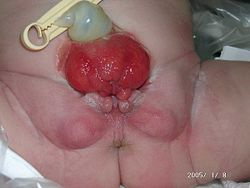Bladder exstrophy

Editor-In-Chief: Prab R Tumpati, MD
Obesity, Sleep & Internal medicine
Founder, WikiMD Wellnesspedia &
W8MD medical weight loss NYC and sleep center NYC
| Bladder exstrophy | |
|---|---|

| |
| Synonyms | Exstrophy of the bladder |
| Pronounce | N/A |
| Specialty | N/A |
| Symptoms | Urinary incontinence, epispadias, pelvic bone abnormalities |
| Complications | Urinary tract infection, renal failure, infertility |
| Onset | Congenital |
| Duration | Lifelong |
| Types | N/A |
| Causes | Genetic and environmental factors |
| Risks | Family history, genetic syndromes |
| Diagnosis | Physical examination, imaging studies |
| Differential diagnosis | Cloacal exstrophy, epispadias |
| Prevention | None |
| Treatment | Surgical reconstruction, urinary diversion |
| Medication | N/A |
| Prognosis | Variable, depends on severity and treatment |
| Frequency | 1 in 30,000 to 50,000 live births |
| Deaths | N/A |


Bladder Exstrophy
Bladder exstrophy is a rare congenital anomaly that involves the protrusion of the urinary bladder through a defect in the lower abdominal wall. This condition is part of the exstrophy-epispadias complex, which includes a spectrum of anomalies affecting the urinary tract, genitalia, and pelvic structures.
Pathophysiology[edit]
Bladder exstrophy occurs due to a failure in the closure of the infraumbilical midline structures during embryonic development. This results in the bladder being exposed outside the body, with the inner surface of the bladder visible externally. The condition is often associated with other anomalies such as epispadias, where the urethra does not develop properly, and a separation of the pubic symphysis.
Epidemiology[edit]
Bladder exstrophy is a rare condition, with an estimated incidence of 1 in 30,000 to 50,000 live births. It is more common in males than females, with a male-to-female ratio of approximately 2:1.
Clinical Presentation[edit]
Infants with bladder exstrophy present with a visible defect in the lower abdominal wall, where the bladder mucosa is exposed. The umbilicus is typically low-set, and the genitalia may be malformed. In males, the penis is often short and broad with epispadias, while females may have a bifid clitoris and a short, wide vagina.
Diagnosis[edit]
Diagnosis of bladder exstrophy is usually made at birth based on the characteristic physical findings. Prenatal ultrasound may suggest the diagnosis if there is an absence of a visible bladder and other associated findings such as a low-set umbilicus and abnormal genitalia.
Management[edit]
The management of bladder exstrophy involves surgical correction, which is typically performed in stages. The initial surgery aims to close the bladder and abdominal wall, and subsequent procedures may address the reconstruction of the genitalia and urinary continence. Multidisciplinary care involving pediatric urologists, surgeons, and other specialists is essential for optimal outcomes.
Prognosis[edit]
With advances in surgical techniques, the prognosis for individuals with bladder exstrophy has improved significantly. Many patients achieve urinary continence and have normal renal function. However, long-term follow-up is necessary to monitor for complications such as urinary tract infections and renal impairment.
Also see[edit]
| Congenital Disorders | ||||||||
|---|---|---|---|---|---|---|---|---|
This congenital disorder related article is a stub.
|
| Urology | ||||||||||
|---|---|---|---|---|---|---|---|---|---|---|
|
Ad. Transform your life with W8MD's Budget GLP-1 injections from $75


W8MD offers a medical weight loss program to lose weight in Philadelphia. Our physician-supervised medical weight loss provides:
- Weight loss injections in NYC (generic and brand names):
- Zepbound / Mounjaro, Wegovy / Ozempic, Saxenda
- Most insurances accepted or discounted self-pay rates. We will obtain insurance prior authorizations if needed.
- Generic GLP1 weight loss injections from $75 for the starting dose.
- Also offer prescription weight loss medications including Phentermine, Qsymia, Diethylpropion, Contrave etc.
NYC weight loss doctor appointmentsNYC weight loss doctor appointments
Start your NYC weight loss journey today at our NYC medical weight loss and Philadelphia medical weight loss clinics.
- Call 718-946-5500 to lose weight in NYC or for medical weight loss in Philadelphia 215-676-2334.
- Tags:NYC medical weight loss, Philadelphia lose weight Zepbound NYC, Budget GLP1 weight loss injections, Wegovy Philadelphia, Wegovy NYC, Philadelphia medical weight loss, Brookly weight loss and Wegovy NYC
|
WikiMD's Wellness Encyclopedia |
| Let Food Be Thy Medicine Medicine Thy Food - Hippocrates |
Medical Disclaimer: WikiMD is not a substitute for professional medical advice. The information on WikiMD is provided as an information resource only, may be incorrect, outdated or misleading, and is not to be used or relied on for any diagnostic or treatment purposes. Please consult your health care provider before making any healthcare decisions or for guidance about a specific medical condition. WikiMD expressly disclaims responsibility, and shall have no liability, for any damages, loss, injury, or liability whatsoever suffered as a result of your reliance on the information contained in this site. By visiting this site you agree to the foregoing terms and conditions, which may from time to time be changed or supplemented by WikiMD. If you do not agree to the foregoing terms and conditions, you should not enter or use this site. See full disclaimer.
Credits:Most images are courtesy of Wikimedia commons, and templates, categories Wikipedia, licensed under CC BY SA or similar.
Translate this page: - East Asian
中文,
日本,
한국어,
South Asian
हिन्दी,
தமிழ்,
తెలుగు,
Urdu,
ಕನ್ನಡ,
Southeast Asian
Indonesian,
Vietnamese,
Thai,
မြန်မာဘာသာ,
বাংলা
European
español,
Deutsch,
français,
Greek,
português do Brasil,
polski,
română,
русский,
Nederlands,
norsk,
svenska,
suomi,
Italian
Middle Eastern & African
عربى,
Turkish,
Persian,
Hebrew,
Afrikaans,
isiZulu,
Kiswahili,
Other
Bulgarian,
Hungarian,
Czech,
Swedish,
മലയാളം,
मराठी,
ਪੰਜਾਬੀ,
ગુજરાતી,
Portuguese,
Ukrainian